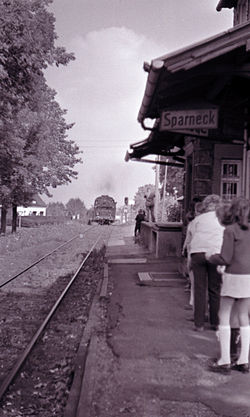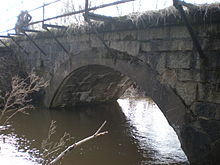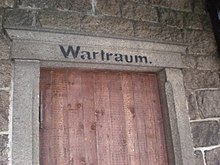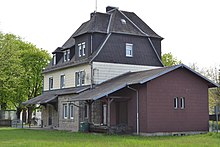Münchberg – Zell railway line
| Münchberg – Zell (Oberfr) | |||||||||||||||||||||||||||||||||||||||||||||||||||||
|---|---|---|---|---|---|---|---|---|---|---|---|---|---|---|---|---|---|---|---|---|---|---|---|---|---|---|---|---|---|---|---|---|---|---|---|---|---|---|---|---|---|---|---|---|---|---|---|---|---|---|---|---|---|
|
Last day of operation at Sparneck station, September 25, 1971
| |||||||||||||||||||||||||||||||||||||||||||||||||||||
| Route number : | 5026 | ||||||||||||||||||||||||||||||||||||||||||||||||||||
| Route length: | 10.15 km | ||||||||||||||||||||||||||||||||||||||||||||||||||||
| Gauge : | 1435 mm ( standard gauge ) | ||||||||||||||||||||||||||||||||||||||||||||||||||||
| Maximum slope : | 25 ‰ | ||||||||||||||||||||||||||||||||||||||||||||||||||||
| Top speed: | 60 km / h | ||||||||||||||||||||||||||||||||||||||||||||||||||||
|
|||||||||||||||||||||||||||||||||||||||||||||||||||||
The Münchberg – Zell railway line , also known as the “Waldstein Express” or popularly known as “Bockela”, was a railway connection between the city of Münchberg and the municipality of Zell , which ran via Weißdorf and Sparneck .
history
As early as 1848, Münchberg was connected to the Ludwig-Süd-Nord-Bahn . The station building, originally planned in the Tuscan style , was designed in a greatly simplified manner due to savings measures. After the completion of the main line, the construction of branch lines began and the Münchberg- Helmbrechts line was opened to traffic on June 1, 1887 . Nine years earlier, the plans for the Fichtelgebirgsbahn, which, in addition to Wunsiedel , Weißenstadt , Kornbach and Tannenreuth, should also touch Zell and Sparneck , before it would have merged into the main line in Münchberg, had been discarded due to high costs and low income. From April 1, 1886, Karriolpost trips from Sparneck to Münchberg brought progress, which enabled the residents of the rural community to connect to early and midday trains in Münchberg. A few years later, the municipality of Zell also set up carriage rides ; the carriages were soon replaced by horse-drawn omnibuses . At 70 pfennigs, a trip in 1886 was relatively expensive, so the carriages were not suitable for general passenger transport. Soon the population wanted a railway line from Münchberg via Sparneck, Reinersreuth and Zell and so on February 24, 1889 a railway committee was convened in Sparneck, eight representatives from Münchberg, nine from Sparneck, eight from Zell and one each Reinersreuth and Immerseiben belonged. The mayor of Münchberg at the time, Friedrich Schoedel, was chairman.
At a meeting on March 10th in Zell, which was also attended by the then member of the Landtag, Schmidt from Helmbrechts, and the royal district administrator Blaß, Weißdorf also applied for inclusion in the planning. The request was unanimously granted after initial hesitation by the mayor of Sparneck, who saw higher freight costs due to the necessary extension. A first application by the city council of Münchberg and the communities of Zell, Sparneck and Weißdorf to the Royal Ministry of State of the Royal House and Foreign Affairs on March 18, 1889 was rejected. After other petitions had also been rejected in the following two years, the company would have been ready in the meantime to realize the railway as a private project of the municipalities, also on the initiative of the local companies. The last petition for the time being, dated October 1, 1895, was also unsuccessful. It was not until four years later that the Münchberg – Zell line was included in the draft local railway law under serial number 17 (§§ 85-88) , and six months later, on March 10, 1900, the construction of the line was approved.

On the same day, the Münchberg town clerk Ludwig Zapf , who first suggested the construction of a train in the Münchberg-Helmbrechtser Zeitung , sent a telegram from Münchberg to Sparneck, Weißdorf and Zell with the words: “Train approved. Flags out! Music! Moving. ”From newspaper articles from that time it emerges that the news was celebrated in the congregations with shots of joy, torchlight parades, flags and the ringing of church bells. The first measurements were made in August 1901 before construction work began on September 10th. The substructure was completed in February 1902 and the laying of the tracks could begin. Almost six months later, on September 7, 1902, the route was open to work trains and was released for the first test drive on October 14. The first free rides for the population took place three days later. On October 18, 1902, the line was officially opened by train at 5:08 a.m. from Zell. Four years later, on December 31, 1906, the project showed a deficit of 1985 marks. In the following years, apart from a few minor disruptions, operations ran smoothly. In the winter of 1941, for example, operations had to be stopped due to large snow drifts, as well as when the bridge over Kirchenlamitzer Strasse was blown up on April 14, 1945. In November 1954, rail buses of the VT 95 series were used on the line for the first time , which heralded the end of steam operation. Nevertheless, the last journey with a steam locomotive took place on September 29, 1962. The locomotive 64 239 used up to then was replaced by the diesel series V 100 .
On September 25, 1971, nine years later, the history of the local railway ended with the last passenger train, which, on the initiative of the Hof Railway Club, drove again from Zell to Münchberg with a class 86 steam locomotive . The reason for the closure of the line was that the cost of maintaining the line was too high (approx. 1 million marks). In 1971, passenger counts were started in order to be able to calculate the need for buses after operations had ceased. By relocating a 20-ton loading crane from Schwarzenbach to Münchberg, the loading of the granite blocks from Reinersreuth could be relocated to the city's train station, which completely lost the use of the railway line that had been used as a siding track until then. The tracks were finally dismantled from August 21 to September 8, 1972.
The endeavors of the newly established Fichtelgebirge-Frankenwald Local Railway Working Group to keep the route as a museum railway came to nothing. Nevertheless, a short section of the route up to 1.7 km remained, which serves as the company track for the substation in Mechlenreuth. In 1973 a transformer was delivered to the factory. In June 1981 the Sparneckers put an end to the railway history of their place by deciding to demolish the railway building. All that remains of him is the former station sign made of granite. Today the track is in bad shape. The track section is still available up to km 1.7 and is regularly kept free of vegetation, but the former embankment is falling into disrepair and has in places almost completely disappeared due to land consolidation measures or private new buildings.
On October 11, 2018, a train ran the remainder of the route for the first time in many years. A transformer was delivered to the substation and the route was made drivable again especially for this purpose.
Apartments are housed in the train stations in Zell and in Weißdorf. The Eiben stop and the shelter in Reinersreuth have disappeared, as has the train station in Sparneck.
Locomotive use
From 1902 to at least 1906 the D XI was on the route, which was later replaced by the famous glass case . This machine, built for one-man operation, managed all operations on the route until at least 1923. The GtL 4/4 was then used until 1935 , which was eventually replaced by class 64 standard steam locomotives . This type of locomotive was in use on the line until steam operations were discontinued in 1962. After the cessation of steam locomotive operations, diesel locomotives cope with the operation. Until 1972, both the V 100 locomotives and the VT 95 series , which had already been in service during the 1950s, were on the road.
VT 95 series
Buildings of the local railway
Since plans had already been drawn up for a station building in solid construction for the Falls-Gefrees line, which was built at the same time, these were also adopted for the buildings in Weißdorf and Sparneck on the Zell-Münchberg line. In addition, each ward received a separate toilet facility . At the terminus in Zell, a main building with a loading hall and waiting room, an auxiliary building with toilets and a locomotive depot were built. The Reinersreuth stop was given a wooden bus shelter, while the Eiben stop only had a bench that was integrated into the station sign. In the years that followed after the line was shut down, some of the buildings were demolished, including the outhouses in Zell, Sparneck and Weißdorf in the 1970s. They were followed by the shelter in Reinersreuth. The final step was the demolition of the station building in Sparneck in 1982.
Reinersreuther Granite Works
The local railway brought great economic benefits to the granite works in Reinersreuth , as the ground granite blocks had to be transported to Münchberg on inadequately developed roads beforehand. Even if one tried to get as close as possible to the plants in Reinersreuth when planning the route, a 582 meter long industrial track had to be planned in order to be able to drive onto the plant premises. The plant itself had to ensure that the safety regulations were observed, which meant that the necessary locking bar and the two level crossings could only be closed and opened by trained employees. A bell signal also ensured safety. Even after the line was closed, it was retained along its entire length as a company track for the granite works. In this way, the plant could be operated until May 1972. To do this, the wagons were first pushed onto the siding and then pulled to the loading platform by means of a cable winch. The locomotive could then pick up the loaded wagons and pull them towards Zell. Only there you could reconnect and put the locomotive on the right side of the train going back to Münchberg. Münchberg station, then equipped with a total of five through and eight side tracks, now has only one head track for rail traffic towards Helmbrechts and two through tracks. The sidings to Zell are still used as siding.
literature
- Roland Fraas: MEC 01 Münchberger Eisenbahnfreunde eV : 100 years of the Münchberg - Zell local railway “WALDSTEINEXPRESS” . Münchberg 2002, OCLC 164938286 .
- Gernot Dietel, Roland Fraas: Railway in Münchberg 1848–1998 . 1st edition. Münchberg-Helmbrechtser Zeitung Verlag, Münchberg 1998, ISBN 3-938463-01-5 .
- Wolfgang Bleiweis, Ekkehard Martin, Stefan Winkler: Franconian branch lines then and now - Upper Franconia . Egglham / Munich 1986.
- Kerstin Schäfer: The high-rise buildings of the Upper Franconian branch lines. History, inventory and conversion . Michael Resch, Coburg 2013, ISBN 978-3-944237-05-3 .
Web links
Individual evidence
- ↑ A maximum (mean) slope of 17 per thousand results from the SRTM altitude data.
- ↑ a b Urban History Working Group: Railway in Münchberg 1848–1998 (= contributions to Münchberg's urban history. Volume 1). P. 72.
- ↑ a b c Urban History Working Group: Railway in Münchberg 1848–1998 (= contributions to Münchberg's urban history. Volume 1). P. 73.
- ↑ Urban History Working Group: Railway in Münchberg 1848–1998 (= contributions to Münchberg's urban history. Volume 1). P. 74.
- ↑ a b c d e Roland Fraas: 100 years of the “Waldsteinexpress” local railway (MEC 01 Münchberg eV). P. 5.
- ↑ Urban History Working Group: Railway in Münchberg 1848–1998 (= contributions to Münchberg's urban history. Volume 1). P. 82.
- ↑ Roland Fraas: 100 years of the “Waldsteinexpress” local railway (MEC 01 Münchberg eV). P. 6.
- ↑ Roland Fraas: 100 years of the “Waldsteinexpress” local railway (MEC 01 Münchberg eV). P. 41.
- ↑ Roland Fraas: 100 years of the “Waldsteinexpress” local railway (MEC 01 Münchberg eV). P. 43.
- ^ Münchberg – Zell: Trains again . In: Lok Magazin . No. 12/2018 , p. 34 .
- ↑ Roland Fraas: 100 years of the “Waldsteinexpress” local railway (MEC 01 Münchberg eV). Pp. 9-14.
- ↑ Roland Fraas: 100 years of the “Waldsteinexpress” local railway (MEC 01 Münchberg eV). Pp. 20-30.
- ↑ a b Roland Fraas: 100 years of the “Waldsteinexpress” local railway (MEC 01 Münchberg eV). P. 35.
- ↑ Roland Fraas: 100 years of the “Waldsteinexpress” local railway (MEC 01 Münchberg eV). P. 39.


















